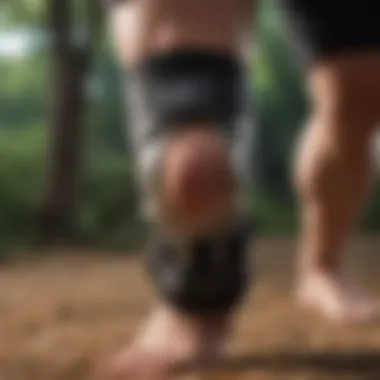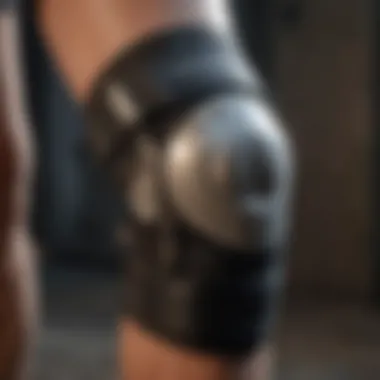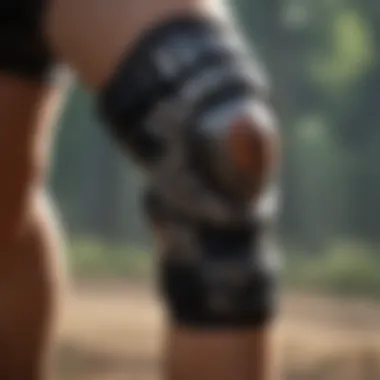Top Knee Braces for ACL Recovery: Ultimate Guide


Intro
Knee injuries, particularly those involving the anterior cruciate ligament (ACL), are common in sports and active lifestyles. Recovery from a torn ACL can be a lengthy process, requiring both physical therapy and support devices. Selecting the right knee brace plays a crucial role in stabilizing the joint, providing comfort, and facilitating recovery. In this guide, we explore various knee brace options available for ACL injuries, their features, and how they can aid in rehabilitation.
Importance of an Appropriate Knee Brace
Choosing the right knee brace is essential for individuals recovering from a torn ACL. The brace not only helps stabilize the knee but also protects it during the healing process. By understanding the different types of braces available and their respective features, patients can make informed decisions that affect their recovery journey.
Key Points to Consider:
- The level of support needed
- Comfort and adjustability
- Material quality and durability
- The stage of recovery
This guide is aimed at helping readers navigate the complexities of knee braces, emphasizing the need to match the brace with individual recovery requirements.
Types of Knee Braces for Torn ACL Recovery
When it comes to knee braces for ACL recovery, several types stand out:
Rigid Braces
Rigid braces typically offer high levels of support and limit knee movement, making them ideal during the initial phases of recovery. These braces are often prescribed by medical professionals to ensure maximum stability.
Hinged Braces
Hinged braces allow for some flexibility while providing support. They are suitable for patients who have completed early rehabilitation and are beginning to regain strength. This type can be beneficial for those returning to physical activities.
Compression Braces
These braces provide mild support and compression, promoting circulation. While they may not be suitable for all ACL injuries, they can support patients in later stages of rehabilitation.
Functional Braces
Functional braces are designed for active individuals who want to return to sports or high-intensity activities. They provide support and protection against re-injury while allowing for a greater range of motion.
Features to Look For
When selecting a knee brace, certain features should not be overlooked:
- Material Quality: Look for breathable materials that wick moisture and reduce skin irritation.
- Adjustability: Customizable straps offer better fit and comfort.
- Size Options: A proper fit is vital; select the appropriate size to ensure effectiveness.
- Weight: Lighter braces may be more comfortable for extended wear.
Ending
Recovering from a torn ACL is a challenging process that demands careful consideration of supportive aids like knee braces. Each type of brace has specific benefits and is suited for different recovery stages. Understanding these details will equip individuals with the knowledge needed to aid their healing effectively.
Understanding the ACL Injury
ACL injuries are common, especially among athletes. Understanding these injuries is key. Anterior cruciate ligament (ACL) injuries often lead to knee instability and pain. They can disrupt daily life and athletic activities. The choice of an appropriate knee brace is crucial during recovery. It helps in providing stability and supports healing.
Overview of ACL Anatomy
The anterior cruciate ligament is one of the main ligaments in the knee. It connects the thigh bone to the shin bone. The ACL plays a vital role in stabilizing the knee joint. It helps in controlling movements such as sudden stops, jumps, and turns. When the ACL is injured, these functions can become compromised. Understanding its structure is essential for knowing how injuries occur and how to recover effectively.


Mechanism of Injury
ACL injuries often happen during sports activities. They can occur from a sudden twist or direct impact to the knee. Common scenarios include landing awkwardly from a jump or changing direction quickly. This can result in the ligament stretching or tearing. Injuries may be classified as partial or complete tears. Complete tears usually require surgical intervention for full recovery. Knowing the mechanism helps in preventing future injuries and choosing the right brace.
Symptoms of a Torn ACL
Recognizing the symptoms of an ACL injury is crucial. Common signs include:
- Sudden pain: Many report a sharp pain at the time of injury.
- Swelling: This usually occurs within a few hours post-injury.
- Instability: The knee may feel wobbly or give way during activities.
- Limited range of motion: Movement can be restricted, making it hard to walk or run.
If you experience these symptoms, it’s important to consult a healthcare professional. Early diagnosis and treatment can facilitate an effective recovery process.
A torn ACL often requires a comprehensive approach to healing, which includes physical therapy and possibly using a brace for support.
The Role of Knee Braces
Knee braces serve a crucial function for individuals recovering from a torn ACL. These devices can provide support, stabilize the joint, and facilitate recovery. Understanding the role of knee braces is key for maximizing their benefits during the recovery process. Each type of knee brace has its unique purpose, providing different levels of protection and support. Selecting the right brace is critical to manage the healing process effectively.
Purpose of Knee Braces for ACL Injuries
Knee braces for ACL injuries are designed primarily to assist both in recovery and prevention of further injury. They help to stabilize the knee joint, which can be especially important after an injury. By restricting excessive movement, these braces can reduce pain and promote healing. Additionally, they can provide confidence to the user, encouraging them to engage in rehabilitation exercises and daily activities.
Types of Knee Braces Available
Knee braces come in several varieties, each with specific characteristics tailored to different phases of recovery or types of activity. The main types include:
- Prophylactic Braces
- Functional Braces
- Rehabilitative Braces
- Neoprene Sleeves
Prophylactic Braces
Prophylactic braces are designed to prevent injuries during high-risk sports. They are typically made from durable materials to absorb impact and protect the knee. The key characteristic is their supportive structure which restricts lateral movement, helping to safeguard the ACL during activities. These braces are popular among athletes who wish to avoid knee injuries. However, they may limit mobility somewhat, which could be a disadvantage for some users.
Functional Braces
Functional braces are intended for individuals who have already suffered an ACL injury. They assist in providing stability during movement, allowing users to return to physical activities while protecting the knee. The significant aspect of functional braces is their ability to adapt to the user's movements, offering support precisely where needed. This adaptability makes them a favored choice among those in rehabilitation but can sometimes lead to dependency.
Rehabilitative Braces
Rehabilitative braces are utilized during the recovery phase post-injury or surgery. They support the knee while allowing for controlled movement, which is essential for healing. A unique feature of rehabilitative braces is their adjustability, enabling users to modify support levels as they progress in recovery. They are essential for individuals recovering from surgery but may not provide enough support for high-intensity sports.
Neoprene Sleeves
Neoprene sleeves offer support while allowing for a broader range of motion. These braces provide compression, which can reduce swelling and aid in pain management. The key characteristic is their lightweight design, making them easy to wear during daily activities. While neoprene sleeves can be comfortable, they may not provide enough stability for individuals with severe instability issues following an ACL tear.
Selecting the Best Knee Brace
Selecting the right knee brace is crucial for individuals recovering from a torn ACL. The effectiveness of a knee brace can significantly influence the rehabilitation process and the overall comfort of the wearer. Choosing wisely involves evaluating multiple factors, as each knee brace is designed to serve distinct purposes and levels of support. Being informed about these elements ensures that the selected brace aligns with both the recovery goals and lifestyle needs of the individual.
Factors to Consider
Level of Support Needed


The level of support needed plays a vital role in selecting a knee brace. It can impact how securely the knee is stabilized during recovery. Braces that offer higher support can be particularly important for individuals with significant instability in the knee, which is often the case after an ACL tear. A functional brace may be the best option here, as it is specifically designed to provide support during movement and activities. These braces often include rigid structures that facilitate stability while allowing some degree of mobility. However, it's crucial to balance this support with natural movement, as excessive rigidity can lead to muscle weakening.
Comfort and Fit
Comfort and fit are equally important in the selection process. A brace that does not fit properly can lead to discomfort and skin irritation, ultimately hindering the recovery process. When choosing a knee brace, it is essential to look for features like adjustable straps and customizable sizing. This flexibility allows for a more personalized fit, addressing the unique contours of the individual's leg. A poorly fitting brace can cause slippage during activity or pressure points that distract from rehabilitation. Comfort directly correlates with consistent brace use, making this a critical factor in selection.
Material and Breathability
The material of the knee brace is another key aspect to consider. Breathable materials can help manage moisture during wear, which is important for long-term comfort. Options like neoprene are often used in braces for their supportive yet adaptable texture. Such materials can retain warmth, aiding in circulation, but they may cause overheating in some cases. It's important to assess these properties, as enduring discomfort can lead to reduced engagement in essential recovery activities. Thus, material choice should balance support and breathability to foster an optimal environment for the recovering knee.
Adjustability Features
Adjustability features enhance the usability of a knee brace significantly. Many models come with adjustable straps or multi-size options to accommodate changes in swelling or muscle tone as the individual progresses in recovery. This feature is particularly valuable during rehabilitation when the physical state of the knee can change frequently. With adjustable designs, individuals can modify the brace for comfort without needing to purchase additional ones. It is a practical consideration that can also promote compliance in wearing the brace consistently.
Consulting with Healthcare Professionals
Before making a final decision, consulting with healthcare professionals is recommended. Medical guidance is essential for understanding individual needs. Doctors or physical therapists can offer tailored advice regarding the best type of brace based on an individual's specific condition. They can also provide insights into how a brace should fit and when it should be worn during the recovery process. Professional recommendations ensure that the brace used will serve its intended purpose effectively, ultimately enhancing recovery and improving joint function.
Top Recommendations
Selecting the right knee brace after an anterior cruciate ligament injury is crucial for recovery and ongoing stability. This section provides tailored recommendations based on specific needs and recovery stages. Choosing the right brace can influence rehabilitation outcomes significantly. Each brace type serves distinct purposes, and understanding their features can aid in decision-making. It is essential to consider how individual activities and levels of stability may affect selection.
Best Functional Knee Brace
Functional knee braces offer support during activity, making them particularly beneficial for those returning to sports or physical exercise. These braces stabilize the knee joint without overly restricting movement. The knee's range of motion is preserved, which is critical for rehabilitation. An example of a top functional knee brace is the DonJoy Performance Bionic Knee Brace. This device provides a balance of support and mobility, making it suitable for various activities. Its lightweight design is a key feature, allowing for extended wear while minimizing discomfort.
Best Rehabilitative Knee Brace
Rehabilitative knee braces serve to protect the knee during the recovery phase. They limit movement and help ensure proper healing. The Breg Fusion Knee Brace stands out as a strong option in this category. Its adjustable hinge allows for controlled flexion and extension, which is vital to avoid re-injury. Comfortable padding and a secure fit make it less likely for users to experience slippage during daily activities. The emphasis on protection without complete immobilization enables gradual rehabilitation.
Best Prophylactic Knee Brace
Prophylactic knee braces are designed to prevent injuries during high-risk activities. They are commonly used by athletes who may be prone to ACL injuries due to their sport. The McDavid 429 Knee Brace is highly regarded for its protective capabilities. This brace provides extra support to the ligaments, reducing the chance of sustaining further injuries. Built from neoprene material, it offers elasticity and warmth, which can be beneficial for joint health. Its design prioritizes comfort and is especially favored among players in sports like football or basketball.
Best Neoprene Sleeve
Neoprene sleeves provide a more lightweight option for those seeking moderate support during activity. They do not offer the rigid structure of traditional braces, but can aid in compression and warmth, which may enhance comfort. The Shock Doctor 875 Knee Brace exemplifies an effective neoprene sleeve. It offers gentle support without restricting movement. The design encourages circulation, which can help reduce swelling and inflammation, promoting quicker recovery. They are versatile enough to be used casually or during exercises.
Choosing one of these recommended braces can significantly impact recovery and well-being. Each type serves a unique role, addressing specific needs and preferences during the rehabilitation process. Proper selection based on individual circumstances promotes better outcomes for those recovering from a torn ACL.
Using a Knee Brace Effectively
Using a knee brace effectively is crucial for those recovering from a torn ACL. A knee brace can provide the support needed during the rehabilitation process. Proper use aids in stabilization, which is key to regaining confidence and mobility. Understanding the best practices can significantly enhance the recovery outcome.
How to Properly Fit Your Brace
Fitting your knee brace correctly is essential. An improper fit may limit its effectiveness or lead to discomfort. Follow these steps for a proper fit:
- Measure your knee: Use a measuring tape to determine the circumference of your thigh, knee, and calf. Choose a size according to the manufacturer’s sizing chart.
- Position the brace: The brace should sit comfortably above the knee joint. Ensure it wraps securely without pinching.
- Adjust straps: Many braces have adjustable straps. Make sure they are snug. However, avoid over-tightening, as it may restrict blood flow.
Taking the time to fit your brace ensures it offers the right support during activities, resulting in a more effective recovery process.


Duration of Use
The duration for which you should wear your knee brace depends on your injury's severity and the advice from your healthcare provider. Initially, wearing the brace during all activities may be necessary. As recovery progresses, your healthcare professional might suggest:
- Daily wear: For routine tasks and movement, especially in the early stages after injury.
- Wearing during exercise: As your rehabilitation exercises become more complex, the knee brace provides needed support.
- Gradual reduction: As strength returns, you may start reducing its use, focusing on activities that require less support.
Listening to your body is essential. When your knee feels stable enough, and you have regained strength, you can begin to lessen reliance on the brace. But make this decision in consultation with a professional.
Complementary Rehabilitation Exercises
Knee braces support but should not replace rehabilitation exercises. Strengthening surrounding muscles is vital for recovery. Complement your brace use with the following exercises:
- Quadriceps Strengthening: Straight leg raises help to activate the quads without straining the knee.
- Hamstring Curls: These can build strength that supports knee stability.
- Heel Slides: This helps maintain flexibility in the joint and aids in restoring the range of motion.
- Balance Exercises: Using a balance board can improve overall knee stability and prevent future injuries.
Incorporating these exercises into your routine while using a knee brace enhances the effectiveness of your recovery plan. Make sure to work with a physical therapist to develop a routine aligned with your progress and goals.
"Effective use of a knee brace, along with rehabilitation exercises, signifies a comprehensive approach to recovery that fosters long-term knee health."
Potential Limitations of Knee Braces
Understanding the potential limitations of knee braces is essential when recovering from a torn anterior cruciate ligament (ACL). This section highlights some significant concerns regarding overreliance on braces and issues related to skin irritation and discomfort. Grasping these limitations can help individuals make better decisions regarding their recovery strategy.
Overreliance on Braces
It is common for individuals with ACL injuries to depend heavily on knee braces. While these devices provide stability, they may lead to a false sense of security. This dependency might result in individuals engaging in activities that they should avoid during the healing process. Without proper awareness, patients may neglect rehabilitation exercises or the gradual increase of activity levels.
Key Considerations:
- Judging Readiness: One issue with overreliance is misjudging the knee's readiness for certain activities. Relying solely on a brace can delay recovery if individuals push their limits too soon.
- Rehabilitation: The role of rehabilitation cannot be replaced by a brace. Progressing through exercises is crucial for strength and range of motion.
- Muscle Atrophy: Extended use of a knee brace can lead to muscle weakening. When the muscles supporting the knee do not work as intended, it increases vulnerability during recovery and can affect long-term joint function.
"Knee braces should support recovery, not be a complete substitute for muscular strength or coordinated movement."
Skin Irritation and Discomfort
Wearing a knee brace for prolonged periods can lead to skin irritations and discomfort. This can stem from several causes, some of which may include improper fitting or using a brace made from unsuitable materials.
Key Factors:
- Fitting Issues: A poorly fitted brace can cause chafing or pinching at pressure points. This can not only be uncomfortable but may also lead to skin abrasions.
- Material: Some materials can trap heat and moisture, leading to skin rashes or fungal infections, especially during extensive use. It is important to choose braces made from breathable materials that can wick moisture away from the skin.
- Maintenance: Proper maintenance of the knee brace is also crucial. Regular cleaning can help prevent irritations that may arise from accumulated dirt and sweat.
In summary, awareness of these limitations can pave the way for more effective recovery and better use of knee braces. Individuals should consult with healthcare professionals to determine the correct balance between utilizing braces and engaging in rehabilitation strategies.
Closure
In this article, we have explored the crucial aspects of selecting the best knee brace for a torn ACL. Understanding the intricacies of ACL injuries and the supportive role knee braces play is vital for recovery. Knowing the types of braces available helps individuals make informed choices based on their specific needs.
Summary of Findings
The key findings of this article demonstrate that not all knee braces are created equal. The effectiveness of a brace often correlates with the level of support it provides and its fit. The article emphasizes the need to consider factors like comfort, material, and adjustability when choosing a knee brace. It is evident that a proper knee brace not only stabilizes the knee joint but also aids in rehabilitation. Recovery can be a complex journey, and using the right brace is one step in the process.
"A well-fitted knee brace can be a game changer for someone recovering from an ACL injury."
Encouragement for Recovery
Rehabilitation from a torn ACL is more than a physical journey. It requires patience and awareness of the body's signals. While knee braces enhance support, they should complement a broader recovery program involving physical therapy and exercises. Individuals are encouraged to stay proactive in their rehabilitation, consulting healthcare professionals as necessary.
Using a knee brace should not be seen as a crutch. Rather, it is a tool that empowers the person to regain strength and confidence. Continuous engagement in rehabilitation exercises, along with appropriate bracing, can lead to a full recovery. Remember, recovery timelines may vary, but with diligence, progress is attainable.







